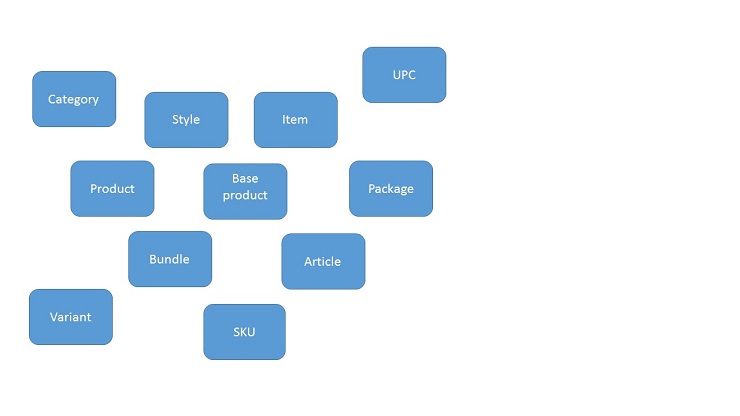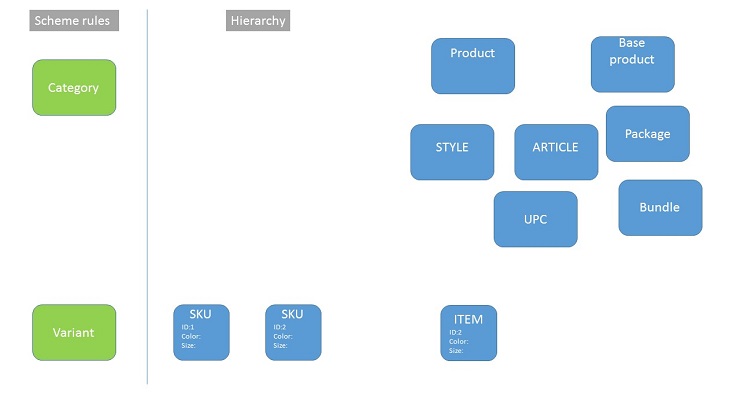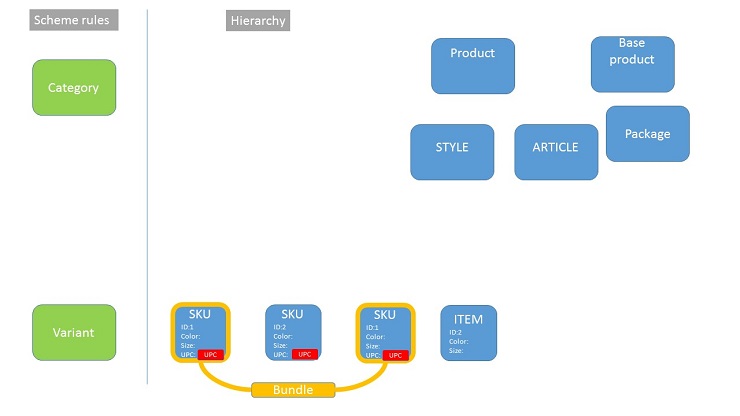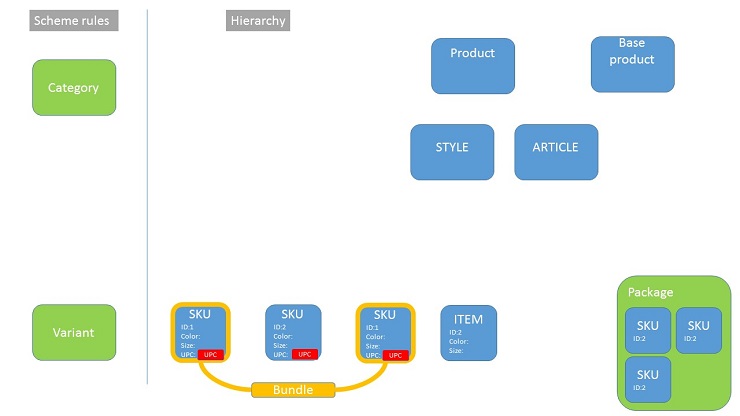Confusion about the Terms
Those of you who have worked with any kind of business system where the business have physical products have most likely come across the terms Product, Variant, and SKU (Stock Keeping Unit). Often, those suppliers of the systems are international, so for Swedish, we have more terms to handle when we add the English terms Item and Style. In addition Article and Category are more terms that are used. How do these terms correlate, is there a clear definition for each of them, and can it be incorrect to use some of the terms together?
What we can see is perhaps a confusion among the terms.

Illustration 1.
Suppliers of PIM systems (Product Information Management) and business systems have often a historical flora of definitions to relate to, where it is probably not unreasonable to think that old data models are the base for the terminology that is used in implementation projects and educational material.
The different terms we are dealing with in e-commerce are usually:
- Product
- Base products
- Variant
- Item
- SKU (Stock Keeping Unit)
- Article
- Category
- Style
- Bundle
- Package
- UPC (Universal Product Code)
The reason that there are several artefacts to describe what consumers buy is primarily to divide the describing attributes on common levels. There is typically a need to have a model where attributes are inherited through a hierarchy to reduce the maintenance of the lowest artefacts.
Scheme Rules
We will start with the describing terms to organize the content. A category is a description of which products to expect in this. It is a way for the Marketing Team to organize the content that the e-retailer sells. A category doesn’t have any describing attributes about the products, rather a common description of all the products common area of use.
A variant describes a unique set of attributes. The product’s nature for different variants are often identical, but there is a difference in for example volumes in a package, size and so on.
The Lowest Artefact
SKU is a term that always describe the lowest artefact. A SKU can never be divided in smaller parts, and the product’s nature is defined by the attributes directly defined by the SKU together with its ancestors. Stock Keeping Unit is what a retailer puts in the warehouse shelf and what the consumer buys. Typical attributes are colour, size, and volume. The term ITEM is an alternative description for the lowest SKU, equal to SKU in a hierarchy.

Illustration 2.
UPC is Universal Product Code. It is a code specific for a manufacturer, identical for two products independent of seller, place, or system. It is often not interesting for a consumer, and can sometime be found internally in the retailers PIM system. UPC is in practice an attribute on the same low level in the hierarchy as SKU.
Two or more SKUs can together be a useful combination for the consumer, a bundle. Often combined with marketing methods as an attractive bundle price. For example a hat and a mittens can be a bundle, a package price. A bundle can for easier administration be on a higher level in the PIM system or e-commerce system, but in the end, the customer buys a combination of two or several SKUs.

Illustration 3.
The Marketing Aspect
Tooth picks can’t be sold one by one, they are typically sold in a package of 200. A larger restaurant would most likely be interested of buying a package of for example 10 of those boxes. As we have concluded that SKU is the lowest defined unit, it should be set up as the little box of 200 tooth picks is the SKU that the retailer sells of the simple reason that you don’t sell tooth picks one by one. The SKU definition should contain an attribute that describe that the number of pieces are 200. Instead, different kind on packages should be set up to meet the markets demand.

Illustration 4.
Hierarchy among the Terms
Product is the generic description of a sellable item. Often you can add attributes on a product that can tell its nature and characteristics. The term Base product is the same as product. The term implies that you can set different variants from a base product.
There isn’t always a need for a level between product and SKU. But there are two known artefacts, these are called Article and Style. These should both describe the product’s nature and performance when there is a need. An example is a pair of jeans available in slim and wide. The product is the same with seams, buttons, pockets, and material. Often both styles are available in different variants when it comes to size and colour. If a shirt is available in one colour and checked, it is a good idea to set these as styles, since both can be sold in different variants when it comes to colour and size.
In industry and production, article is a well-known term. There are cases where article is the lowest level, where article number is equal to SKU. There are other cases where article is equal to style, and the product is sold in different sizes.

Illustration 5.
Now we have probably sorted out the mess we saw before and have more control of the different terms. We called category and variant, scheme rules, since these aren’t artefacts in the model. Products are part of a category but don’t inherit any attributes from the category. Different variations of the products attributes set different variants, but there is nothing that inherits from variants.
Bundle and Package are ways to connect relations between SKU in a marketing way to make the offer more compelling. There are several more examples but we stop here since they are common in PIM discussions.
We did a hierarchy description where we place Product, Style, and SKU, and found synonym descriptions as Article and Item that we placed in an alternative hierarchy description.
Get in touch with us at 3bits if you want to discuss PIM solutions.